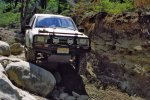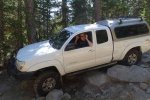shade
Well-known member
There are several reasons why an OEM either wouldn't, couldn't or won't design a smaller chassis to do that.
Do you really think a midsize truck couldn't be produced with a better suspension and a heavier rear axle? I understand that there are reasons why it isn't being sold in NA, but I don't believe it's a technical impossibility.
Based on the fact that the Ranger has been deducted points in head to head comparisons vs the Tacoma for having a stiff ride (it does) is an indication the US market wouldn't settle for something even stiffer, like the Hilux.
As @Dalko points out when he gives props to the Tacoma for flex and dings the Ranger, things like "flex" are important and a lot of folks care about RTI more than payload.....can't have them both, at least when unloaded....unless you have a Unimog, then nothing is off limits, unless you wanna go the speed limit.
I have no doubt that the Ranger can be made to ride quite nicely with aftermarket parts, with or without a load.
Good articulation while providing increased load capacity is possible with better-than-OEM springs. Use a leaf pack with more individual leaves, reduce friction between the leaves, and replace the typical OEM bump stop with something more progressive than a hockey puck. It's not that difficult, and many people have done it at home. OEMs could do it, but they'd rather save money with 3-leaf packs, cheap shocks, and junk bump stops.




